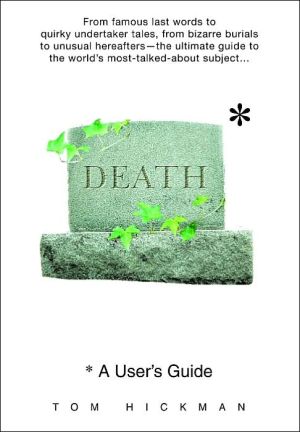Death: A User's Guide
Everything you always wanted to know about life when you’re six feet under.\ Let’s face it, death is one of the most important events in life--and it never hurts to be prepared. Herein you’ll explore such provocative questions as: Is there life after death? Is the Hereafter sexist? And most important: How do you know you’re dead? This eye-opening collection of amusing tidbits, historical facts, and macabre curiosities probes the mysterious state that has stymied scholars and spiritualists...
Search in google:
Everything you always wanted to know about life when you’re six feet under.Let’s face it, death is one of the most important events in life—and it never hurts to be prepared. Herein you’ll explore such provocative questions as: Is there life after death? Is the Hereafter sexist? And most important: How do you know you’re dead? This eye-opening collection of amusing tidbits, historical facts, and macabre curiosities probes the mysterious state that has stymied scholars and spiritualists since the beginning of time. Did you know…* An Australian woman had her husband’s ashes inserted in her breast implants, to keep him close to her heart (see page 118) * Heavy drinking combined with excess body fat can result in Spontaneous Human Combustion (see page 191) * Statistically, you’re more likely to be killed by walking (660–1) than by lightning (55,000–1) (see page 193) PLUS Sex and Death • Graves of the Rich and Famous • Body Snatching and Grave Robbing • Ghosts, Ghouls, and the Undead • And Much More!
Respecting the Dead\ Artifacts for the Afterlife\ You can't take it with you, it's said, but for millennia they did. The Neanderthals began the practice of putting goods in graves fifty thousand years ago, give or take the odd ten thousand years. As they were not the hairy, bulbous-browed knuckle-trailers of popular belief but members of the genus Homo sapiens with anatomically modern brains, it's reasonable to conjecture that, like the civilizations that followed, they thought that existence continued in some place beyond the grave, that a journey to get there was involved, and that the dead needed a few creature comforts to undertake it and to make the afterlife the good life when they got there.\ Not belonging to a consumerist society, the Neanderthals had little to give: food and drink, the odd flintstone ax, fire charcoals. Food, drink, and fire-lighting implements remained the staples in later history, but eating utensils, household items, clothing, and jewelry were added. Different peoples, not surprisingly, reflected their culture in what they considered essential. On a prosaic level, the Arctic Eurasians from Norway to Siberia send off their dead with the reins of a sled, fish, copious amounts of tobacco, and plentiful tallow--the Arctic Circle is generally a gloomy place. More fundamentally maritime races like the Scandinavians, the Anglo-Saxons, and the South Sea Islanders buried their elite dead with their boats, as did the ancient Egyptians, whose world revolved around the sacred Nile. The Twana Indians of the American Northwest seacoast also buried dead in their canoes, although they placed them in trees. Sometimes the Arctic tribes and the Scandinavians set their dead adrift at sea--alight in the latter case, as the Vikings especially rather liked setting things on fire--emphasizing that a journey was being undertaken.\ The practical ancient Greeks (copied by the Romans), assuming that you were likely to have to pay your way in the next world as in this, saw their dead on their way with a coin in their mouths to pay Chiron, the ferryman, who would row them across the river Styx to where they were headed. As a bit of contingency planning the Greeks placed honey cake or bread in the coffin as a bribe to the three-headed dog-demon Cerberus, who guarded the entrance to the underworld. Quite as practical as the Greeks, the Chinese also placed coins in the mouth of the corpse and cakes and bread in the coffin to ward off not Cerberus, but the pack of vicious dogs that awaited the dead--customs continued to this day. But living under a complex and corrupt bureaucracy as they did, and assuming that nothing would be different on the other side, they also placed jade, pearls, and gold leaf in the corpse's mouth. This was to bribe the officials, either in hell to secure their release or in heaven to buy a better class of rebirth on earth. And they still send their dead special paper money, drawn on the Bank of Hell, by burning it. There's a reflection of all this in the British actor Robert Morley asking for his credit cards to be buried with him. After his funeral in 1992 readers of The Times pondered in the letters page what they might appreciate most accompanying them on the other side. Heather Tanner of Woodbridge specified a good map. "I have immense trouble finding my way in this life," she wrote, "so I am extremely worried about the next." "A pair of earplugs," specified Sir David Wilcocks of Cambridge, "in case the heavenly choirs, singing everlastingly, are not in tune." Wrote M. L. Evans of Chester: "In the unfortunate event of the miscarriage of justice and several thousand years ensuing before my sentence is quashed, I will take a fire extinguisher."\ The prodigious amount of worldly goods that went along with the elite deceased in ages past included not only precious artifacts but also armor, weaponry, chariots, pets, and horses. Everyone knows something of the wealth that accompanied the pharaohs into their tombs, but prodigality was in every culture. In the three-thousand-year-old grave of a Scythian warrior prince and his consort excavated in southern Siberia in 2001, for instance, more than 46 pounds of treasure was discovered, including a solid gold quiver and solid gold goblets and necklaces; the bodies were dressed in garments covered in more than nine thousand pieces of gold.\ Living Death for Wives and Servants\ From our perspective, what was most distasteful about trying to ensure that dead rulers, nobles, and heroes could continue in the afterlife in the manner to which they had become accustomed was that it also involved truncating the lives of others. In Sumer (the earliest civilization, from about 3500 b.c.) and the other Mesopotamian cultures of Babylonia and Assyria, in ancient Egypt and early Greece, in Scythia, Mongolia, and Turkey, in Scandinavia and China, and among the Celts of central and western Europe, the Central Americans, and numerous African peoples, it was common practice for servants, soldiers, wives, and dependent children to join their master in the grave. Archaeology suggests that anything between six and eighty people were not unusual for a top banana, but often the funerary retinue was in the hundreds. In the fifth century a.d. five hundred mounted warriors had their throats cut and were buried with Attila the Hun; in the ninth, another five hundred warriors went with the Viking chieftain Raknar into his burial ship. Improbably, according to the thirteenth-century Venetian traveler Marco Polo, more than twenty thousand people who saw the body of the Mongol leader Mangu Khan as it went on pilgrimage to burial enjoyed the privilege of joining him permanently.\ It seems that many of those dependent on the powerful were happy to make the one-way trip in their company. They were, after all, going to what was hoped to be a better place; their job was to serve; and anyway prevailing thought was that, as they belonged in the most absolute sense to those who had departed this world, they too were already dead to it.\ In the classical ancient world women did commit suicide to join their men in the afterlife, and the Roman writer Pomponius Mela observed that among the Celts some wives willingly cast themselves onto the flames of their husbands' funeral pyres. It was a Viking custom too, as it was among Hindu sects in India as late as the nineteenth century. In the same period new widows in New Guinea could elect to be garrotted (as was the Siberian Scythian princess) to accompany their spouses, or buried alive with them--or not, as they choose. In Fiji widows faced the same options but without the "not."\ It's hard to believe that in any period or place human beings who were seen as mere accessories of someone else's life got anywhere by saying "Can we talk about this?" While some wives no doubt accepted their fate, the willingness of others is at least questionable. The myths of Greece and Rome suggested that wives considered it an honor and obligation to die with their deceased lord, but mythology is an idealized collection of as-it-ought-to-have-been stories, and as feminist historians have pointed out, the writers of myth and legend were all male. On this subject they may have been economical with the verite. As to Viking and Hindu wives and concubines electing the fiery exit, there's evidence that, while the choice was meant to be entirely voluntary, considerable pressure was brought to bear on them to "do the right thing." The British who governed India in the nineteenth century were appalled by reports that narcotics were administered to prevent women from changing their minds and that sometimes they were tied to the funeral pyres--which hardly indicated free choice. Noting that during the cremation ceremony the music was deliberately played very loudly--a widow's final words were considered prophetic, and it was thought best that what she really said couldn't be heard--the British prohibited the practice of wifely immolation (suttee or sati, Sanskrit for "virtuous wife") in around 1830, although it took large-scale social reform by succeeding leaders, including Mahatma Gandhi in the first half of the twentieth century, to stop it.\ All in all one can only say that the tenth-century Swedish queen Sigridr the Proud had the right idea. She divorced the old king Eric Sigrsaell precisely to avoid going to the grave with him.\ Universal Treatment of the Dying\ However misguided in our terms other societies have been, one thing remains true: they were doing their best to ensure the postmortem well-being of their dead. Paramount in this was burial or cremation or whatever other means of final disposal was acceptable to the culture. An improper handling of the remains, or none at all, could prevent the dead from making it to their destination--a view strongly held in Egypt, ancient Greece, and Rome; in today's orthodox Judaism an unburied body is an affront to God and to man, and among primitive peoples it causes great concern.\ In ancient Greece a general who failed to provide for the burial of the slain--at the very least a mass grave on the field of battle--was held guilty of a capital offense. The Greeks did not refuse burial to an enemy. No one, they thought, should suffer the fate of Odysseus's friend Elpenor who, "unburied and unwept" on the island of Circe, was left a sad shade, trapped between this world and the next. Some peoples, including the Mongols, Turks, and Germanic tribes, frequently left their enemies unburied precisely to inflict this everlasting punishment. The Arctic tribes used to eat the hearts and livers of dead enemies to prevent their resurrection.\ Almost without exception throughout history, peoples have believed that the soul or spirit of the dead lingers near the body. To the ancient Egyptians this meant both the ka--the dead person's spiritual double--and their ba--the human "personality" that remained to go sight-seeing when it wasn't traveling with the sun god. That is why the Egyptians embalmed their dead; the corpse acted as a kind of home base until ka and ba were reunited with the body in the realm of the dead.\ The Zoroastrians in ancient Persia (and the surviving followers of the religion in Iran and the hundred thousand Parsees in India) believed that the spirit remained for three days after death. In Islam still the spirit is said to watch the rituals and the funeral--a belief also held in contemporary Transylvania and Hungary and not unknown in Catholic Ireland--and to be present in the family home for up to a month and in the grave for up to a year.\ The corollary of such belief was that treating the dead with respect had an element of self-protection about it: if the watching just-dead were satisfied with the arrangements, then they wouldn't turn nasty--as they were capable of doing (see Chapter 6). There was also the likelihood that if the departed departed as satisfied customers, they would confer blessings--good luck, prosperity, children--on their descendants. Medieval Europe was an enthusiastic signatory to this idea, as East Asia and much of Africa still are. There was also some insurance: when the time came for your permanent departure, those already gone ahead might just be in a position to put in a good word for you.\ Naturally enough, there were and are differences from culture to culture in the way that the dying are treated--in the West, for example, people expect to do their dying in bed, whereas Hindus are taken from their beds and laid on the earth when death is imminent--but the customs and rituals of death are surprisingly similar in whatever time or place. The corpse is washed (it was once commonly held that, polluted by death as it was, it would otherwise be refused entry to the hereafter). This is usually done with water--for Hindus, drawn, if possible, from the Ganges or other sacred river--but not always. The Zoroastrians use cow's urine, while in Africa oil or clarified butter is preferred. In ancient Greece and Rome old women washed and laid out the body, a practice that was prevalent in Western culture until the first half of the twentieth century. Muslim men wash men and women wash women; if a woman must be washed by a male relative, it must be through her clothes. A Muslim who dies among strangers should only be rubbed with sand. Unique to Judaism is that the washing is done by a specialized holy fellowship, the chevra kadisha. Washing may be dispensed with for Islamic martyrs (depending on the method of death, there may be no choice), whose martyrdom already purifies them for the afterlife.\ Displaying the Deceased\ All societies try to have their dead looking their best for their final big day. The ancient Egyptians spent weeks or months on the business (see Chapter 3), stuffing women's breasts (not with silicone implants but with straw, sand, linen, and mud), refashioning nipples from buttons and eyes from obsidian or brass balls, and giving the bodies a nice coat of ochre: red for men, yellow for women. As they virtually took bodies apart in the embalming process, putting them back together with a few add-ons was somewhat necessary. In the modern world, Americans are widely regarded as overdoing similar if infinitely more sophisticated enhancements. In The American Way of Death, Jessica Mitford poured scorn on such funerary cosmetic ministrations as eye caps, face formers, denture replacers, lip pinning (smile please) and the injection of facial hollows. "Alas, poor Yorick!" she wrote. "How surprised he would be to see how his counterpart today is whisked off to a funeral parlour and is in short order sprayed, sliced, pierced, pickled, trussed, trimmed, creamed, waxed, painted, rouged and neatly dressed--transformed from a common corpse into a Beautiful Memory Picture." We'll come to the slicing, piercing, and pickling in due course. As to the transformation aspect, not much has changed in the forty years since Mitford's book was first published. At least a dozen U.S. companies offer funerary cosmetics to the trade: "Try Nadene Cover-Up Cosmetics and discover what over 7,000 other funeral directors already know. 100% guaranteed absolutely risk free." Risk free? To whom, don't you wonder?\ The odd cosmetic lick is not unknown in the British way of death, but routinely, nothing more. The British dead are dealt with at the undertaker's, not the funeral parlor--and the British have never been attracted to open casket viewing.\ When it comes to what the departed should wear to face the final curtain, some cultures have favored simplicity; most have buried their dead in their finest or in fur; and the elite dead have invariably bowed out in full regalia. Throughout history the shroud has been the commonest covering. This was usually a plain linen winding sheet, tied or sewn at top and bottom, although Europeans in the Middle Ages waxed it to slow decay, called it "cerecloth," and left a hole at the head, to make it easier for the dead to arise at the final judgment. The grave garb of Muslim and Hebrew, the shroud was adopted by the early Christians partially as a protest at the Roman custom of dressing the (elite, male) dead in the pomp of their purple-trimmed togas. The ordinary Jewish shroud is of white muslin; linen is reserved for the priestly classes.
Introductionix1.Respecting the Dead1Artifacts for the Afterlife1Living Death for Wives and Servants4Universal Treatment of the Dying9Displaying the Deceased13The Vigil and Other Customs18The Funeral: A Good Send-off21Wailing and Other Demonstrations28Mourning, Noon, and Night30Prayer: A Power Tool332.Heaven, Hell, or Reincarnation?37Dead Boring Underworlds37Soul: Food for Thought40Reincarnation: Back to the Beginning43The Underworld Gets Upgraded47For Heaven's Sake50Is the Hereafter Sexist?57What the Hell!60Is Heaven Elitist?62Dead Reckoning: The Judgment of Sin64Eternity Is a Long, Long Time703.What Do You Do With the Remains?75Grave Concerns75The Physiology of Death78Burials and Bones82Hang-ups About Cremation84Mummification: Breaking the Dust-to-Dust Circuit90Miracle Busting97Early Modern Pickling99The World's Most Famous Embalmees102Cryonics: A Cool Way of Preservation106Day-to-Day Embalming109Funky Exits1134.Burial Grounds, Coffins, and Monuments118The One-Upmanship of Death118Rise and Fall of the Churchyard123"Garden Cemeteries" and Beyond128Buried Under What Marker?135Rest in (Disturbed) Peace138Where Are the Famous Buried?142Buried in What Container?144The Eco Argument149Rise of the Undertaker--The "Dismal Trader"152R.I.P.-off?154The Funeral Service1615.When You've Got to Go ...163When Will It Happen?163How Will It Happen?167Done to Death169Heretics, Deviants, Witches171Man's (Ingenious) Inhumanity to Man174Kill Thy Neighbor179Oops, Accident!181Cause of Death: Stupidity184Odds Against Death by Mishap190Suicide: The Self-Destruct Button191Microbes: Natural-Born Killers199Death and the "Little Death"205How Do You Know You're Dead?2086.Dead Nervous (or) Nervous of the Dead212Precautions Against Death212Welcome Home to the Dead216Ghosts, Ghouls--and the Undead219Attractions of Death225Is There Anyone There?228Rest in Pieces232Grave Robbing: The Oldest Profession?236Body Snatching: A Nice Little Earner239Buried Alive244NDEs: Back to the Future?2507.Not so Grim Reminders253Quipping Death into Shape253Words, Words, Words257Last Words ... Maybe262Goodwill, Ill Will266Obits: The Smallest Biographies274The Epitaph: Final, Final Words281Afterword291Index295








